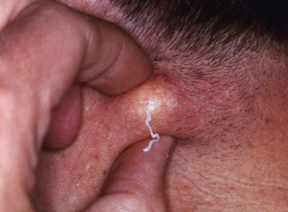I am sure that many of you have seen some of the videos on YouTube with people “popping” enormous “zits” with handfuls of pus come out. Despite the allure and excitement that all of you seem to have with these videos, they are actually not zits…most often they are furuncles! And, again, I totally get the excitement of wanting to squeeze those suckers, they should actually be seen by an HCP and treated. How do you know the difference between a zit, cyst, and furuncle? Read on my friends, we can figure out the difference, what should be seen by an HCP, why, and what you can feel free to squeeze and post to YouTube all on your own!
What is the Difference Between a Zit and a Cyst?
So a zit (AKA a blemish, pimple, spot, acne, etc) is the result of excess oil getting trapped in your pores, along with the naturally shedding skin cells, glue together and cause blockages, leading to a pustule/whitehead/zit, and they are very superficial. As we all know, acne is usually treated with over the counter medications that help to kill off the bacteria that can pool and cause the inflammation, as well as face washes that dry up the oil production. A cyst is a bit of a different beast; they are enclosed structures filled with either gasses, liquids, or semi-solid substances (i.e. pus) that are under the skin, within your organs, etc. When I am referring to cysts here, I am talking about the kind that are just under the surface of your skin, but fully enclosed, not the ones that you might have in your ovaries, bladder, etc, purely talking superficial sebaceous cysts. These cysts can be caused by infection, a blockage of a duct (causing a fluid build up), an inflammatory process, or just genetic bad luck! Usually you feel an abnormal lump underneath the skin, and that is a cyst; not painful, just a lump that is there, more annoying than anything. The treatment of cysts really depend on the size, where they are, and how annoying they are for you; but they either need to be lanced (opened up with a scalpel) and drained UNDER STERILE CONDITIONS, then treated with antibiotics and left as is to close on their own or they can be packed with gauze to help drain any excess fluids from the area. Sometimes, depending on placement, they need full surgical removal (usually for deeper cysts), and, again, treatment with antibiotics.
What is a Furuncle?
A furuncle is also known as a boil, which is an infection (usually due to Staphylococcus aureus) of an entire hair follicle and the surrounding skin areas, and are usually caused by staph infections. The skin goes from tender, pink, warm skin to firmer, and then you can feel a lump under the skin (not much unlike a cyst). The main difference is that the bigger a furuncle gets, the more painful it gets, until that fluid/pus it is filled with is released; sometimes they open on their own, or they should be opened by an HCP (again under sterile conditions!) Also, you may feel tired, have a fever, or get some itching over the site before the furuncle is visible, which is another difference between a zit or a cyst. Occasionally, but rarely, they will heal on their own, but most often they need to be opened by an HCP, under sterile conditions, especially if they continuously come back, are near your spine, on your face, or cause general health symptoms like fatigue and fevers, because you are at a high risk for having a generic systemic infection that can be deadly, known as sepsis. Plus, if you open these on your own and they don’t fully empty and heal well, they can spread and grow larger and in different places. Plus, something that is opened by a non-professional that doesn’t heal well can cause scarring. Yikes!
 |
| Furuncle |
 |
| draining furuncle |
 |
| Zits |
| Cysts |
Is There Anything I Can Do to Prevent Cysts and Furuncles?
Good hygiene like showering every day can go a long way (not just for preventing infections, but to keep people from steering away from you due to stench), wearing clean clothes (especially changing clothes after/between workouts), and using antibacterial soaps can help to prevent bacteria from growing and thriving on your skin. And good hand washing also is really imperative in preventing infections (all sorts) but Staph is lurking everywhere, and washing your hands before touching anything on your skin (especially if the skin is open, even if you can’t see it like cracked winter dry skin) can really help to prevent bacteria from embedding in your skin and creating infectious processes. If you have a furuncle, then do not share towels or wash cloths with anyone because you can spread the Staph infection, and same advice if you have a cyst that has been opened or a zit that you “popped”. It is really important to make sure that we are keeping all wounds clean and preventing infections at any cost.
So, What Can I Pop?
Honestly, every dermatologist out there would kill me for this one, but the only thing I will tell you is that you can pop a zit at home….I know, nothing YouTube-able, sorry! Even popping zits is really bad because it can cause long-term damage and scarring, and you might not completely empty the pore and cause a larger infection, but it is the best of the three worst choices you have 
Yours in Good Health
B


